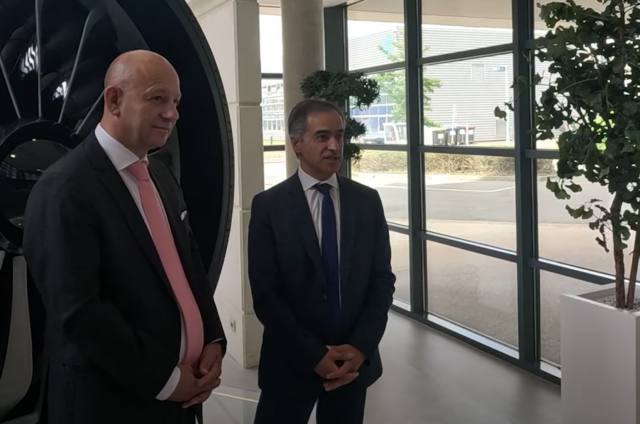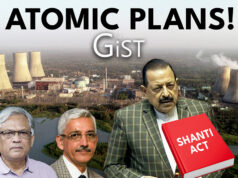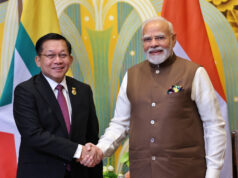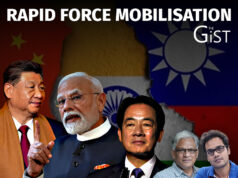NEW DELHI: During Prime Minister Narendra Modi’s recent visit to Paris, India and France announced that they would work towards co-developing a military jet engine and a roadmap for the same would be prepared by Safran and DRDO by the end of the year. Already, a memorandum of understanding has been signed between Safran and HAL for developing a helicopter engine. Bharat Shakti Editor-in-Chief Nitin A. Gokhale who was in Paris to cover the PM’s trip visited Safran’s military engines division and spoke to Christophe Bruneau, Executive Vice-President and GM, and Jean-Michel Missirian, Senior VP, Strategy & Business Development – India to know more about the company’s plans for India going forward. Here’s the transcript of the interview.
Nitin Gokhale (NG): Hello and Welcome to BharatShakti.in. I’m speaking to you from Paris or just outside Paris at the Safran military engine facility, and speaking on the eve of Prime Minister Narendra Modi’s visit to France. And of course, looking at the future plans and projects that Safran military engines division has for India and what are the partnerships that they are looking at in the future? With me to talk about the company’s plans and what they intend to do in India is Senior Executive Vice President Christoff Bruno (CB) and the man in charge of business development in India, Jean Micheal (JM). They are here to give us an idea of what exactly Safran intends to do. Let me start with you Christoff. What is Safran’s history in India? People need to know what this company is all about. And does it have any relationship with India?
CB: Good morning. Yes, I think it’s very important to state that Saffron has been working with India for more than 65 years. We started with space activities. You may know, we provide engines for the Indian rocket for sovereignty, especially the Viking engine. We also worked on the guidance system for which we had transfer of technology in India. We are working on helicopter engine with some joint ventures in these sectors and on civil and military engine activities for aircraft. So, for many years we have been working with India on many different sides.
NG: That’s good to know. A lot of people will not know because it’s all behind-the-scenes activities that go on. You’ve been an India watcher and engagements that you’ve been doing with India for some time, what are the plans for commercial engine activities that Safran has for India?
JM: The LEAP engine that we are producing together with our partner GE, the CFM joint venture is a very successful engine. CFM Leap engine right now is pushing probably more than 75% of the commercial fleet in India. It has been very successful and what we plan to do on the commercial side, at least, is to implement its plan. It’s decided to implement a maintenance shop for the LEAP engine, providing maintenance capability for the Asia Pacific area as well. So, it’s a very important move from Safran. A huge investment is to be made together with other manufacturing and production capabilities. We have also implemented this in the Hyderabad manufacturing centre for manufacturing LEAP parts. And we are building up, I would say, on the commercial aspect because of the volume of those, a complete ecosystem of industry in order to bring the right level of competency and capability so as to provide these aero engine parts with the right level of performance and competitiveness. So there are many companies working with us which are already integrated.
NG: So I think you would create an ecosystem going forward, and India needs to develop the kind of supply chain and also skill sets with which you will help?
JM: Exactly. This is exactly the purpose. Our move is to build up the ecosystem with the commercial part because we can leverage all the investments which are necessary to produce these type of parts with the right level of performance and use this ecosystem also to bring military capacity, military capability as well, because the military part is making technology whereas the commercial part brings the volume.
CB: Today, we have more than 3000 people in India and in the coming years we will have around 10,000 people in India.
NG: That’s good to know, because India is also looking to create the ecosystem and provide jobs to many engineers and skillful young people who are coming up through the education system.
CB: And that’s very important when you are creating a partnership, you know, to have local people working for your products and developing the ecosystem, as you mentioned, because we can do nothing just with a very high-level skill ecosystem. It is very important for us, especially when we have plans to have partners in small and medium companies.
NG: You also have a plan for the MRO? What are the timelines that you are looking at for the MRO?
CB: We will start in India in 2025 as we set up the plant for the civil engine.
JM: The land has been bought and the construction of the building has been signed up. So operations would commence in Hyderabad, you know, in the SEZ zone of Hyderabad, very close to the manufacturing centre. And we have also planned the extension of this MRO shop in order to handle every engine maintenance capability, especially for the M88 for which we expect a lot of orders. And I think it would be very good for India to have this deeper level of maintenance capability already in place in India in order to gain turnaround time. So it’s also an opportunity to build up the capability and the skills necessary to maintain such a high performance engine and high quality engine.
NG: So let’s turn our attention to military engines now. Last year, HAL and Safran signed a memorandum of understanding for the rotary wing helicopter engine for the Indian Multi-Role Helicopter (IMRH). Tell us a little bit about those plans.
CB: The idea is to develop in India, capability through co-development for the new type of helicopter and also in order to transfer that technology and to allow India to grow in this market and maybe also to further export.
It’s a similar military engine. Jean-Michel, talked about setting up of facilities. We will start them in 2024, and to increase the availability of the M 88 engine in India and also transfer of technology in order to build up step by step capability in India.
JM: If I may add, is the rotary engine sector, the cooperation with HAL is a long-time cooperation. There is no helicopter flying without parts coming from Safran. Shakti engine is also a long-time cooperation. And then there is a transfer of manufacturing capability taking place. And now the idea is to jointly develop the engine for the IMRH. Not only this, we also have this cooperation with HAL regarding maintenance. And we have set up a maintenance facility for helicopter engines in Goa. So this facility which we are building up right now, we’re taking a big flight and we expect a lot in this joint development for the IMRH, not only for the Indian market but for potential exports as well.
NG: Correct me if I’m wrong, this is one of the unique partnerships in the sense that this has nothing to do with government to government, but just between Safran and HAL?
JM: Yes, it’s a self-funding type of investment in order to tackle this specific market for IMRH in India. Yeah, it has nothing to do with government funding. (It’s a unique partnership in that sense) That’s correct. Yes. It’s almost like the model of, I would say, the CFM, it’s a joint venture. And so, production would be shared 50-50 (and the work share has been decided?) Everything has been decided and we hope to have a decision inked within a few days.
NG: Let’s talk a little bit about the Rafale offsets. Is there a possibility of doing something there? Are you doing something already on the offsets of Rafale?
CB: Of course, we have committed to doing it. I think that is one of the commitments. We do what we say and we say what we do and we are committed. So we already started to fulfill our obligation in terms of offsets. We have also planned on the military side, you know, and to set up more and look at the ability to support small and medium companies. We are on track.
NG: And so this will contribute to the Make in India policy. How would that fit into the new policy?
JM: In fact, I would say if I start from the beginning, you know, aero engine manufacturing is a very complex area of competencies. I mean you have much more technology in an aero engine than any other thing because they have a lot of mechanical parts, you know a lot of technology and so these technologies cannot be built just like that. This is why we use the high volume market of the commercial engine to build up this capability. And so we believe that by injecting the technology and the role of the company in helping small companies and even bigger companies in order to get to the right level of performance, we build up this sovereignty capability in order to get the competencies in India for future markets, like the AMCA engine.
NG: Talking about the AMCA engine, there is a lot of speculation in the Indian ecosystem that Safran has offered to co-develop and co-manufacture a jet engine for India, which can be used for the advanced medium combat aircraft. What is the reality and where are you in that?
CB: As I mentioned, we have a long history of cooperation between Safran, GTRE and DRDO. So we are working with these two organizations in order to propose to India a new engine for the new fighter AMCA, which is not a secret. We are working on it in order to propose the best for India’s sovereignty.
NG: If I can play the devil’s advocate in this and contrary opinions that come, one of the apprehensions people have expressed is that it’s going to take too long a period of ten years and also the cost? People have spoken about these two as the impeding factors in not going forward and maybe even during this visit of the prime minister, this will not come through is what everybody is speculating?
JM: Those who know about aero engines know what goes into designing an engine has nothing to do with manufacturing an engine. So you can get the competency of manufacturing engine but getting the knowhow of designing an engine is another story. And if you look at engine designers and engine providers worldwide, typically the development of a brand new engine is in the period of 15-20 years, taking into account all the background of all these people. So it’s not unusual to have this type of timeline. Regarding the budget, again for building the technology, getting the technology, acquiring the technology for this type of aircraft, if you look at the cost on paper for designing an American engine or even a Russian one, it is very huge. I would say we are pretty much in the ballpark of what these companies are using.
So, this is the main difference between co-developing an engine while acquiring the technology and the design capability as compared to manufacturing an engine, where you get only manufacturing capacity. There is a big difference and that is sovereignty.
NG: And you’re willing to transfer the entire technology when the co-development happens, it is all going to be co-owned by an Indian entity, correct?
JM: Right. That’s the plan. We believe that our proposal is to provide the full sovereignty capability to India.





